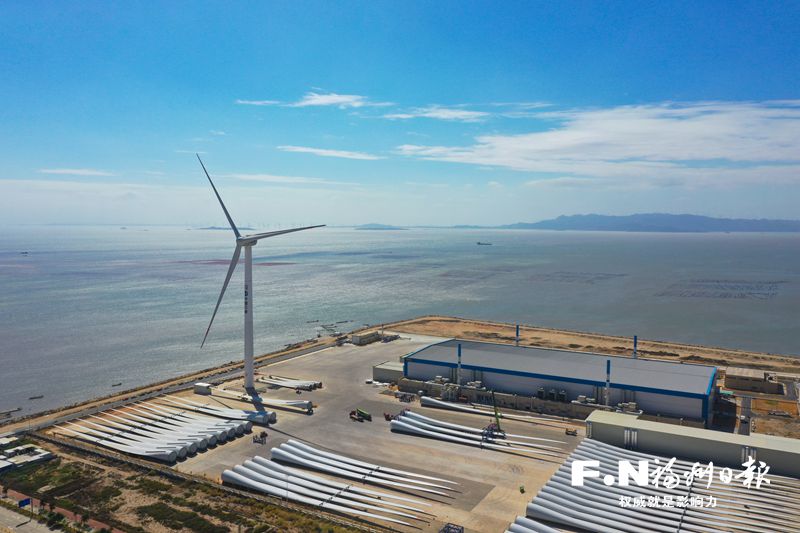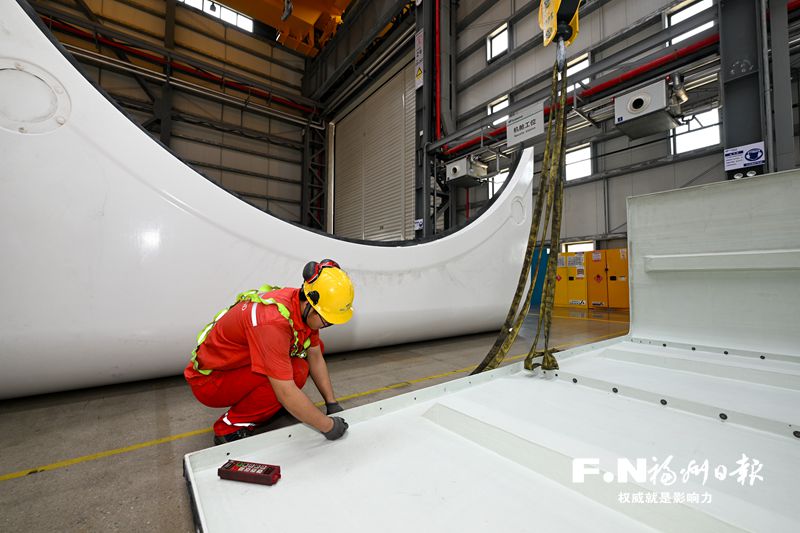On the southeastern coast of China, the sea breeze blows fiercely. Situated by the Taiwan Strait, one of the world’s three major wind corridors, Fuzhou has become one of the regions with the richest offshore wind power resources in China.
More than 600 years ago, Zheng He, during his seven voyages to the Western Oceans, would wait for favorable winds at Taiping Harbor in Changle, Fuzhou, before setting sail. With the wind as his paddle, he peacefully visited over 30 countries and regions, marking the dawn of the Age of Exploration. More than six centuries later, on the shores of Xinghua Bay in Fuqing, a group of “wind chasers” continues to carry the spirit of exploration. They chase the wind and sing as they conquer the seas, overcoming challenges to build towering “wind turbines,” setting new records in the offshore wind power equipment industry and drawing attention from both China and around the world.
Following, racing, and leading! In just five years, from 2019 to the present, the Fujian Three Gorges Offshore Wind Power International Industrial Park has successively launched China’s independently developed 6.7 MW, 8 MW, 10 MW, 13 MW, 13.6 MW, 16 MW, 18 MW, and 26 MW offshore wind turbines. These achievements have propelled China’s offshore wind power equipment manufacturing to leap forward, creating a complete, globally competitive wind power industry and supply chain. This also provides strong support for China’s “dual carbon” goals.

Fujian Three Gorges Offshore Wind Power International Industrial Park. Photo by Chi Yuan
From 2 Megawatts to 20+ Megawatts
“National Treasure” Achieves 100% Domestic Production of Components
On the morning of the 12th, a historic moment was marked at the Fujian Three Gorges Offshore Wind Power International Industrial Park—the official offlining of the world’s largest 26-megawatt offshore wind turbine. Developed by China Dongfang Electric Corporation, this turbine not only holds fully independent intellectual property rights but also represents the latest achievement in the rapid technological advancement of China’s entire wind power equipment industry chain.
At this moment, Zhao Di, Deputy Director of the Science and Technology Information Department at Dongfang Electric Wind Power Co., Ltd, was deeply moved. He clearly remembered when he first started his career in 2010, and the largest offshore wind turbine then had a single unit capacity of less than 2 megawatts.
From 2 megawatts to 20+ megawatts, how has the power of large wind turbines continuously grown? The key lies in the ever-lengthening blades.
According to experts, the power output of a wind turbine is directly related to the area swept by the blades as they rotate. Larger blades mean a greater swept area, which in turn allows for the generation of more electricity.
Zhao Di explained that the 26-megawatt offshore wind turbine, which was just rolled off the production line, is currently the largest in the world in terms of single-unit capacity and rotor diameter. The hub center of the turbine stands at a height of 185 meters, equivalent to the height of a 63-story residential building. The rotor diameter exceeds 310 meters, and the swept area reaches 77,000 square meters, the size of 10.5 standard football fields.
However, scaling up wind turbines is not merely a matter of increasing size. The structure and material applications of the turbines require technological innovation to support this growth. “The 26-megawatt turbine has overcome the challenges of aerodynamic-structural coupling, establishing a collaborative design approach for both blade aerodynamics and structure. It achieves multiple design objectives, including ultra-long blades with low load, high efficiency, and lightweight properties, providing solutions for the efficient conversion of wind energy,” said Zhao Di.
How many components make up a single turbine? Zhao Di revealed that the 26-megawatt turbine is composed of over 30,000 parts, all with fully independent intellectual property rights. This marks the first time that all components of an offshore wind turbine have been 100% domestically produced. Key components, including the generator, blades, bearings, and electrical control system, are all at the world’s leading level, ensuring complete autonomy in both the industrial and supply chains.
Despite abundant wind energy resources, the marine environment is complex. To address the challenges posed by high average wind speeds, intense salt mist corrosion, and powerful typhoons in most of China’s seas, the newly launched wind turbine features a fully sealed structure to prevent salt mist corrosion. It is also equipped with dual anti-typhoon technologies, and its intelligent system can automatically adjust the rotor’s orientation based on wind conditions to minimize the impact of strong winds. Testing has confirmed that this turbine is capable of withstanding super typhoons with winds up to level 17. In September, a turbine utilizing this system successfully withstood the impact of the super typhoon “Yagi.”
After numerous tests, comparisons, and technical breakthroughs, Zhao Di and his team spent 16 months overcoming challenges in product planning, conceptual design, component prototyping, and final assembly. The 26-megawatt offshore wind turbine was successfully rolled out. With an average wind speed of 10 meters per second, a single turbine can generate 100 million kilowatt-hours of clean energy annually, enough to power the households of 55,000 average families for a year.

At the Fujian Three Gorges Offshore Wind Power Industrial Park, engineers are assembling wind turbines. (Photo by reporter Chi Yuan)
From a Thousand Acres of Sandy Land to an Industrial Hub
World-Class Offshore Wind Power Industry Cluster Emerges in Fuzhou
What began as a vast stretch of sandy land has now transformed into a world-class offshore wind power industrial cluster that integrates technology research and development, equipment manufacturing, testing and certification, construction, installation, and operation and maintenance. This blueprint for the Fujian Three Gorges Offshore Wind Power International Industrial Park was conceived nine years ago.
In June 2015, the Three Gorges Corporation and Fujian Province joined forces at the China Strait Innovation and Project Fair to sign a strategic cooperation agreement. The agreement outlined plans for constructing an offshore wind power equipment manufacturing base and the large-scale development of offshore wind projects.
Lei Zengjuan, the Party Secretary and Executive Director of Three Gorges Corporation Fujian Company, vividly recalls his first visit to the industrial park’s land in Jiangyin Port, Fuqing, in 2016. “It was a thousand acres of sandy land, barren and desolate.” At that time, China’s offshore wind power industry faced significant challenges, including the late start of large-capacity offshore wind turbine manufacturing.
Before 2017, Europe was the global leader in the offshore wind power industry. At that time, Europe accounted for 88% of the world’s total installed offshore wind capacity. The first 8-megawatt offshore wind turbine had already been grid-connected, with plans for large-scale installation of 6-megawatt and larger capacity turbines. In contrast, China accounted for only 11%, and the mainstream offshore wind turbines in the country had a single-unit capacity still below 5 megawatts.
Lei Zengjuan and his team rose to the challenge, determined to establish China’s offshore wind power industry in Fujian, a region rich in wind energy resources. “Fujian boasts abundant wind energy resources and is a prime location for offshore wind power development. If we conquered this high ground, developing offshore wind power in other regions, such as Guangdong, Jiangsu, and Liaoning, would be much easier,” said Lei Zengjuan.
In Fuqing’s Xinghua Bay, Three Gorges Corporation invested in building the world’s first international large-capacity prototype wind farm, which is hailed as the “Olympic” arena for offshore wind turbines. Here, 14 wind turbines with capacities of 5 megawatts or more, produced by eight renowned domestic and international manufacturers, competed to determine the most advanced offshore wind power equipment providers to settle in the industrial park. Among them, Goldwind’s 6.7-megawatt offshore wind turbine was the first product to be developed, marking Goldwind’s first step into the realm of large-capacity offshore wind turbines.
“For Goldwind, this was both a challenge and an opportunity. Through its efforts, Goldwind successfully turned this challenge into an opportunity for the innovative development of large-capacity offshore wind turbines. This success was made possible by the competitive platform created by the Three Gorges Corporation, and by drawing on the best practices and experiences of its partner enterprises,” said a representative from Fujian Goldwind Science & Technology Co., Ltd.
In July 2017, the main construction of the Fujian Three Gorges Offshore Wind Power International Industrial Park began in Fuqing. “We conducted countless rounds of discussions and research to determine which manufacturers could be invited to settle here,” said Lei Zengjuan. With a unified planning approach, the park coordinated the upstream and downstream segments of the offshore wind power industry chain, ensuring no duplication of industrial development within the park. It also provided customized factory spaces and corresponding facilities to accelerate the formation of the industrial chain.
Enterprises from both upstream and downstream sectors have gathered here, creating a dynamic environment where they motivate and collaborate with each other. In just two years, the industrial park attracted leading enterprises such as Goldwind, Dongfang Electric, CRRC, China Water Conservancy And Hydropower Engineering Bureau No.4, and LM Glasfiber, forming a complete industry chain covering structural components, motors, blades, and complete turbines. The park now has the capacity to produce and deliver over 3 million kilowatts of wind turbines and key components annually, along with after-sales services.
Offshore wind power is a typical chain-based industry. Since its entry in Fujian in 2015, the impact of the Three Gorges Corporation on local enterprises in Fujian has extended beyond the industrial park, radiating to related companies across various subfields of the province. As of now, the Three Gorges Corporation has deepened its cooperation with over 50 local Fujian enterprises, including Fujian Energy Petrochemical Group Co., Ltd., Fujian Shipbuilding Industry Group Corporation, and Zhangzhou Development Co., Ltd., working together to promote the innovative development of Fujian’s offshore wind power industry chain.
“Only by striving can we succeed,” said Lei Zengjuan. “After years in Fujian, the spirit of hard work has already become part of our blood. Our journey is to conquer the deep blue sea. Through hard work, we aim to achieve high-level independence and self-reliance in the offshore wind power sector, contributing to the realization of China’s modernization, where humanity and nature coexist harmoniously.”
From Nearshore to Deep-Sea
Harnessing Wind for a Green Future
Looking out over the coastline stretching along Xinghua Bay, wind turbines rise from the blue sea like towering pillars. As their blades gently turn, a continuous stream of green energy is delivered to millions of households.
Cheng Shuangbao, the manager of the power operations department at the Fuqing Strait Power Generation Co., Ltd., a subsidiary of China Three Gorges Corporation Fujian Company, has spent more than 2,000 days and nights at the offshore wind farm in Xinghua Bay, Fujian. His main job is to climb up to the nacelle of a wind turbine, which is over 100 meters above the ground, to inspect the hydraulic pitch system, main control system, gearbox, generator, and other components. “On average, I may need to go out to sea 3 to 5 times a week for inspections. But if it’s busy, I might need to climb the turbines twice a day for maintenance,” Cheng said.
Looking back at his first experience climbing to the outside of a wind turbine nacelle, Cheng admitted that his hands were shaking, and he was too scared to move. But over time, he got used to it. He understands that wind turbines are like the human body, and any malfunction of a single part can cause problems. It is the dedication of these high-altitude guardians that ensures the stable operation of the wind farm.
Cheng Shuangbao has witnessed the rapid development of the Xinghua Bay Offshore Wind Farm, from the first-phase prototype test field to the second-phase project. He has seen the shift from a mix of imported and domestic turbines to the second-phase project, where all turbines are domestically produced, marking a significant step toward the localization and self-sufficiency of offshore wind energy equipment. “In 2018, the first phase of the Xinghua Bay Offshore Wind Farm consisted of 14 turbines, 3 of which were imported. By 2021, the second-phase project installed 45 turbines, all of which were domestic,” Cheng explained.
As of now, the Xinghua Bay Offshore Wind Farm has installed a total of 59 wind turbines, with an installed capacity of 357.4 megawatts. Since its commissioning, the farm has generated over 5.2 billion kilowatt-hours of electricity, equivalent to a reduction of approximately 1.57 million tons of coal consumption and a decrease of around 3.83 million tons in carbon dioxide emissions.
Globally, energy security and the need to address climate change have made more countries acutely aware of the importance and urgency of energy transformation. It is estimated that an offshore wind turbine of the same power capacity as a land-based turbine can generate 70% more electricity annually. Offshore wind energy offers several advantages, including abundant resources, higher utilization hours, no land or water usage, and the potential for large-scale development.
The Xinghua Bay Offshore Wind Farm is located in nearshore waters, which have long been the primary area for global offshore wind energy development. In recent years, as nearshore wind energy resources near saturation, the focus has shifted toward deep-water offshore wind energy, emerging as a new direction for global offshore wind power development.
Fuzhou continues to lead the way in this transition. In July last year, the world’s first 16-megawatt offshore wind turbine completed grid connection and power generation in the offshore waters of Pingtan, approximately 35 kilometers from the mainland, marking an important breakthrough in China’s offshore wind power capabilities, including advanced equipment manufacturing and deep-sea offshore wind power construction.
Today, through subsea cables, this clean energy is transmitted into the grid and delivered to households. It not only provides electricity within Fujian Province but also enables surplus power to be exported, optimizing resource allocation on a larger scale. Notably, “Fuzhou-made” products are widely used in China’s offshore wind development and have been exported to countries such as the UK, Tanzania, Vietnam, Bolivia, and Ethiopia, becoming a new symbol of international production capacity cooperation.
From independent turbine research and development to a fully controllable industrial chain, and now venturing into deep-sea waters, Fuzhou’s wind power professionals are actively pursuing their dreams, leading the offshore wind power industry. They are supporting the development of advanced equipment manufacturing and contributing more green energy to help realize Chinese modernization. (Fuzhou Daily, reporters Yan Lanping and Qian Jiayi)







